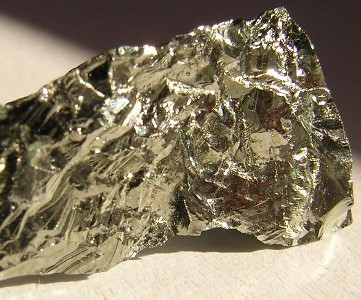germanium

Germanium. Credit: Wikipedia.

Germanium, a metal 'grown in this form for making transistors, was unknown when Mendeleyev proposed his periodic table. However, in 1871 he predicted the existence of an element with the properties of germanium and called it eka-silicium, from silicium (the old name for silicon) and the Sanskrit word eka, meaning 'one'. Germanium was discovered in 1886, 15 years after he had made his prediction.
Germanium (Ge) is a gray-white metalloid element of group IVA of the period table. Germanium takes the form of a brittle crystalline solid whose structure resembles that of diamond. It occurs naturally in sulfide ores of silver, copper, and zinc, and in certain coals, and is extracted as a by-product of processing them. It is important in transistors, rectifiers, and other similar semiconductor devices, and is also used in alloys and for lenses and windows for infrared radiation.
The chemical properties of germanium are intermediate between those of silicon and tin; it reacts with the halogens,
oxidizes in air at 600°C, and is attacked by concentrated oxidizing
acids and by fused alkalis. It forms covalent tetra- and divalent compounds
(see below). Its most common isotope is 74Ge (36.54%).
The existence of an element with the properties of germanium was predicted in 1871 by the Russian chemist Dmitri Mendeleyev. He called it eka-silicium, from silicium (the old name for silicon) and the Sanskrit word eka meaning 'one'. Germanium was discovered in 1886, 15 years after he had made his prediction.
| atomic number | 32 |
| relative atomic mass | 72.59 |
| electron configuration | 1s22s22p63s23p63d104s24p2 |
| relative density | 5.35 |
| melting point | 937°C (1,719°F) |
| boiling point | 2,830°C (5,126°F) |
Compounds of germanium
Germanium (IV) oxide (GeO2) is used in high-refractive-index glass. Melting point 1,086°C.
Germanium (IV) chloride (GeCl4) is a colorless liquid intermediate in the extraction of germanium and the preparation of most of its compounds. Melting point –50°C, boiling point 84°C.
The germanes are a series of volatile hydrides resembling the silanes.


